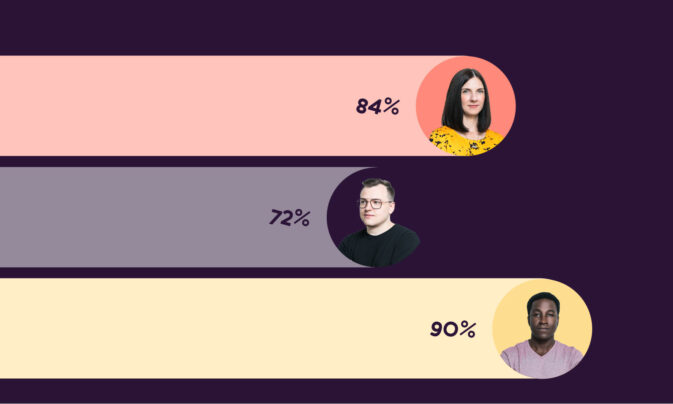While recruiting techniques vary from company to company, recruitment best practices are almost universal.
From a well-planned and documented candidate screening process to a strong employer brand and a smart approach to candidate shortlisting – the best recruiting practices are high-level guidelines all great recruiters follow.
Need some examples?
Here are 7 recruitment best practices for 2023 and beyond.
1. Use Skills Tests to screen candidates efficiently
We can’t ignore the fact that many people lost their jobs in 2022. While the pandemic wreaked havoc on the job market in 2020, the fear of a looming recession caused a layoff tsunami in the tech industry in 2022.
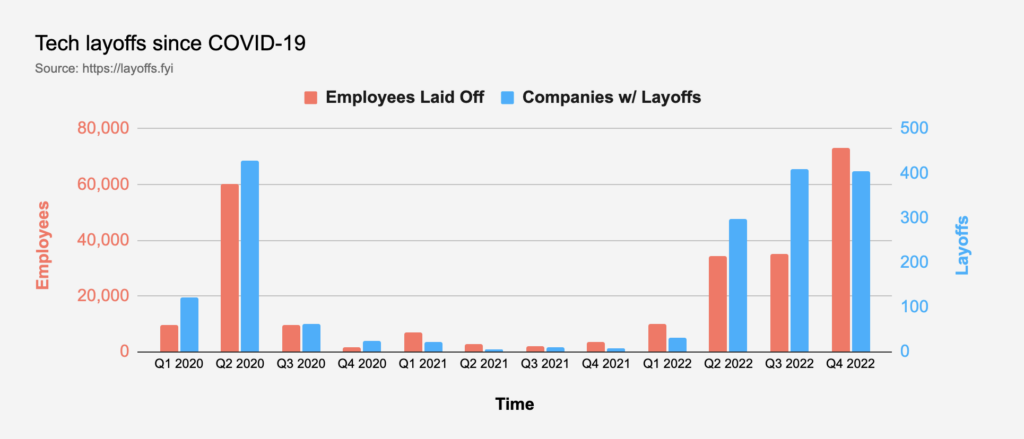
In the USA alone, more than 150k tech workers have lost their jobs since May 2022, and unfortunately, the future’s not looking too promising either.
There are and will be lots of great candidates looking for work, so you can count on much higher candidate numbers applying for your roles. And since most recruiting teams lost people during the layoffs, the importance of ensuring an efficient recruiting process will be at an all-time high.
A high volume of tech-savvy job seekers will affect the initial stages of your recruitment process when the pressure is on to eliminate the bulk of the under-qualified candidates – and not let the right candidates slip through the cracks.
So one small innovation that can change your recruitment game in 2023 is skills assessments.
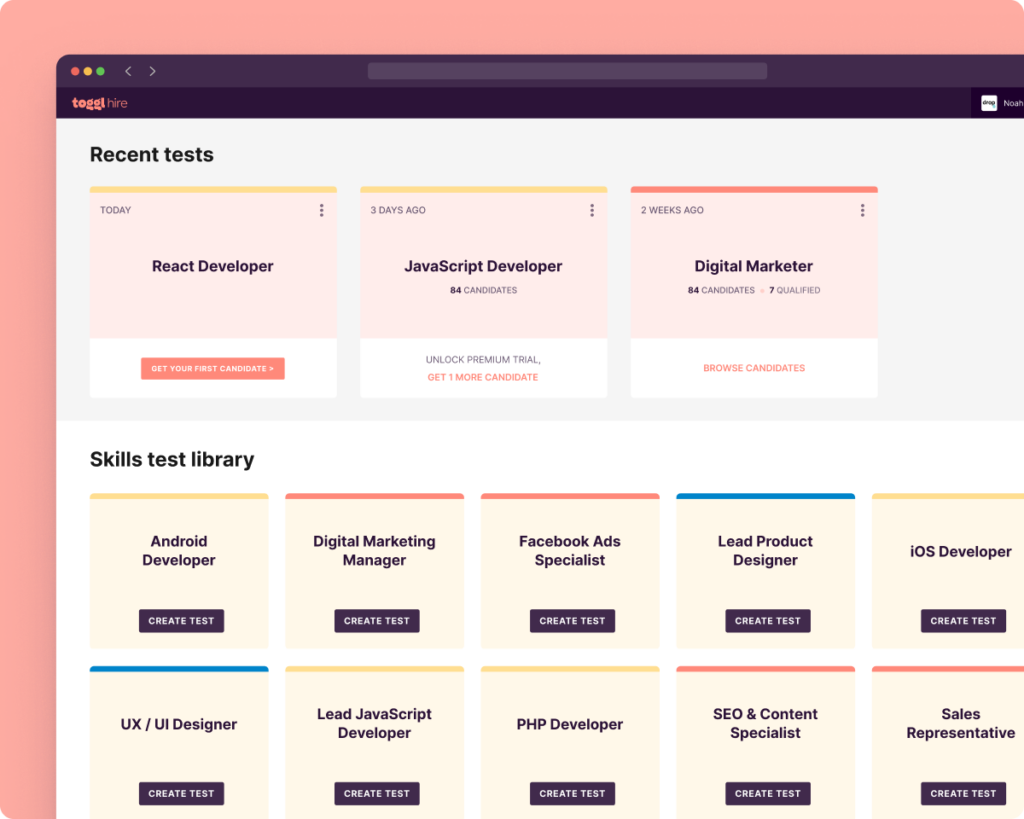
Instead of reading through endless resumes, save yourself hours of valuable time and use a skills test at the application step. Here’s what the recruiting process can look like after adopting a tool like Toggl Hire:
- Select a pre-built skills assessment template for any role, including development, IT, marketing, sales, product, or any other.
- Customize the test to match exact job requirements and add a touch of employer brand magic – your logo, team picture, and brand colors.
- Add a link to the skills assessment in your job descriptions, and let candidates have fun!
Candidates will relish the opportunity to apply via a quiz-like test rather than a tailored CV. And you will enjoy a faster, more reliable recruiting process that instantly identifies the best of the bunch based on their test scores. You can speed up your hiring by as much as 80%, plus candidates love the experience, so you’ll boost your employer brand at the same time, too.
2. Polish up your job ads
Of course, you will always get a portion of unqualified job seekers applying because they’re simply desperate for work. But there is also another reason you may be getting bad applicants.
It’s your job descriptions 👀
For many candidates, your job ad is the first point of contact with your company. And these days, you really need to go the extra mile to create something that grabs the attention, accurately reflects what the job candidates will do, and, at the same time, entices them to apply.
A few simple tips that can help boost the number of quality candidates applying:
- Scan the job description for any biased language. Diverse talent is more than just a best recruitment practice – more like a life rule, amiright? If you want your job postings to resonate with all types of candidates, make sure your recruitment strategy employs the best DE&I recruitment practices. A tool like Textio can help with writing an inclusive, neutral-sounding job posting.
- Make your job advertisement performance-based. While a paragraph on company culture and employee value proposition can help attract potential candidates, it’s the actual day-to-day responsibilities, goals, and management philosophy that will make the best candidates stop in their scrolling tracks. Too many job openings sound like they were copied and pasted from an old template, and that can really hurt your recruitment efforts.
- Put the salary in the job description! No amount of recruitment marketing can make candidates apply for a job with no salary range. Candidate experience starts way before the first interview, so don’t ignore this best practice for fear of losing top talent. It’s probably one of the cardinal recruitment sins to take a candidate all the way through the hiring process just to lowball them with a below-market offer.
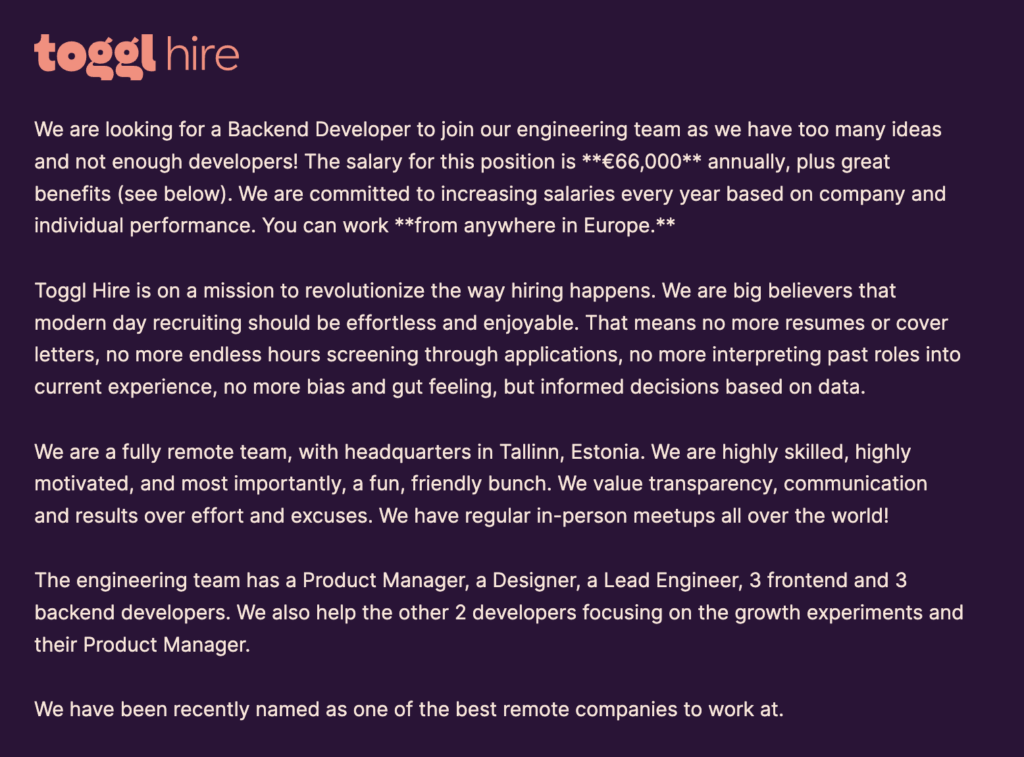



3. Reach out to passive candidates
We’ve written about the benefits of hiring passive candidates, and there are many. Not to mention that building a passive talent pool is one of the hottest recruitment trends for 2023.
A lot of times, the reason why you can’t find your ideal candidate is because they’re already happily employed with someone else – and not actively hunting for a new job. Or, as it seems now, passive job seekers are clinging to what they already have.
The recent tech layoffs have everyone in stitches: candidates are scared to jump ship just to get laid off a few months down the line – and who can blame them?
However, that doesn’t stop you from giving it a try. Besides LinkedIn, you can try reaching out to passive candidates on specialized platforms (such as Stack Overflow for developers) or social media.
In the past, we hired a few people by promoting job ads on Facebook. In fact, many of the developers at Toggl were not actively seeking a new job opportunity when they took the quiz test – but they couldn’t resist checking it out after scoring highly on the test. So if you’re reviewing your recruitment strategies for next year, we’d recommend focusing on three things:
- Start building a talent pool of passive job seekers
- Gamify your application process to get passive candidates to engage
- Invest in creative social media recruiting campaigns
4. Remember top applicants from the past
If it’s not your first time hiring, you probably have a database of past applicants who left a good impression on you. It may be a shot in the dark, but you never know if they are looking for new work at the moment.
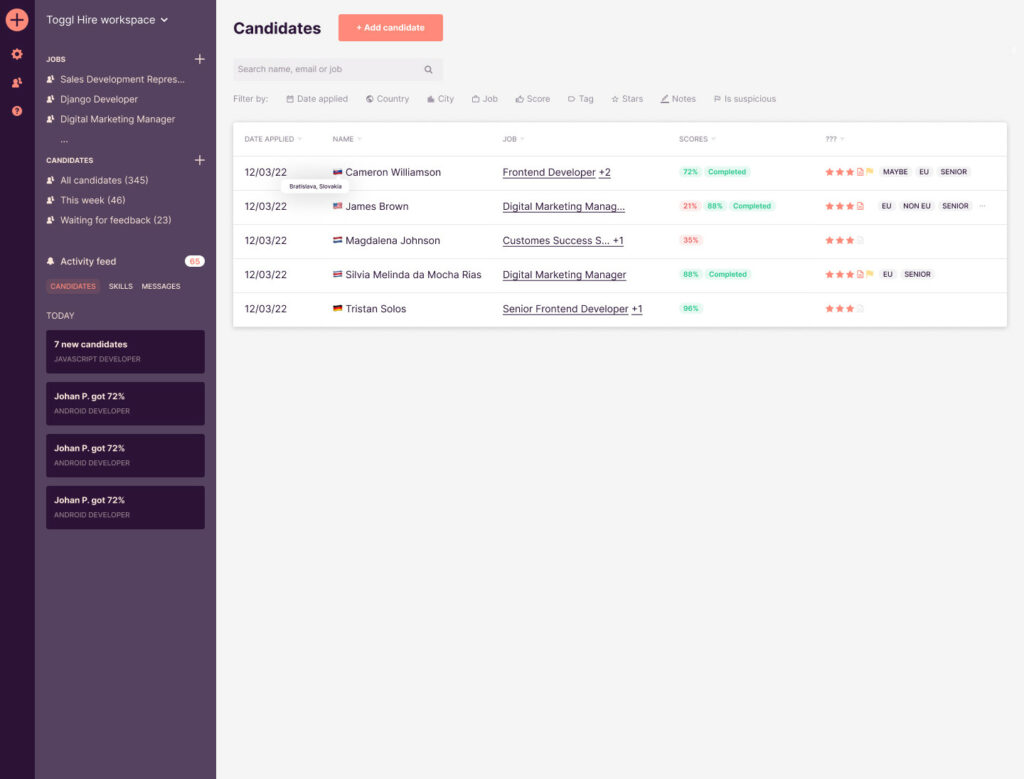
The biggest benefit is that you already know the candidate to some extent, especially if they’ve gone through your entire recruitment process and dropped off at the last interview stage.
Since you last talked to them, they could have only gained more experience, and if they tick all the other boxes, they’re worth reaching out to. It costs zero dollars to send an email, and for all you know, they might refer quality candidates to you if they’re not interested themselves.
5. Don’t rely just on resumes and the interview process
In 2023, some things need to stay in the past.
While resumes are still a staple of recruitment best practices, things are changing. You may argue that someone unemployed has a lot of time on their hands to create the perfect resume, but that’s exactly the point. You want to hire the best person for the job and not the best resume writer or designer.
While you may not want to completely remove resumes from your recruitment process, you can and should give them a less significant role in determining who gets interviewed and moved along the hiring process. Highly embellished resumes can set off a chain of unfortunate blunders in the standard recruiting process:
- Well-written CVs get candidates into a screening interview
- A recruiter, who’s not a subject matter expert, struggles to screen technical skills
- Candidates make it into a round of interviews with the hiring manager
- The best interviewer gets hired
See the risk here?
Neither resumes nor interviews are particularly effective at identifying top candidates. However, it doesn’t mean you need to bin your hiring process completely. Simply adding an additional homework assignment step to the recruitment process can dramatically reduce the risk of a bad hire.
In 2023, take-home assignments are bound to secure a spot on the list of best recruitment practices – why ask about a candidate’s work experience if you can get proof of competence?
6. Reduce friction in the application process
Hundreds of candidates are likely to apply for your open roles, especially if you’re offering remote work at these times. While a good chunk of them may not be a good fit, you want to make sure that everyone completes their application from start to finish.
Apps have spoiled us with great user experience, and candidates expect something similar with their job applications. In other words, less friction means better candidate experience.
Audit your recruitment process and take note of any potential candidate drop-off points. For instance, if your applicant tracking system requires candidates to re-enter their entire work history after the CV upload, you’ll lose the best candidates. People have zero patience for outdated recruitment processes, and smart recruiters know that.
So how can you devise a more efficient hiring strategy? Here are a few tips:
- Require as little as possible at the very beginning of the hiring process. For our open roles at Toggl Hire, we only require candidates to take a skills test to apply. We have a candidate information form at the end of the test to collect key information and support the Linkedin authentication method. If candidates sign in via Linkedin, we have the most important contact data in one go.
- Eliminate a cover letter as a requirement. It’s 2023, and we’re reviewing good recruitment practices; let me assure you that the cover letter has nothing to do with excellent hiring processes! Are you looking for a top performer or a talented novelist?
- Provide instant feedback via test results. Flipping the application process on its head could help you automate candidate feedback. Interested candidates will apply via a skills test and get an instant response – if they pass the required minimum score threshold, they move forward. And you can always ask candidates to upload their CVs when submitting the test – this way, you’ll have the best of both worlds. This is one of the recruitment best practices we intend to keep in 2023 and beyond.
7. Say no quickly
Of all recruitment best practices, this is probably the easiest (and arguably most impactful!) one to implement.
No one likes the feeling of being led on, or worse – ghosted, so it’s important to communicate effectively. Just because you have a large volume of candidates, it’s not an excuse to keep your candidates hoping to hear back from you. And yet, if 1,000 candidates apply for an open role and 980 are a bad fit, you can’t send that many rejection letters in such a short time frame.
You can resort to using an applicant tracking system (ATS), but bear in mind that these platforms come with faults of their own. There have been numerous debates about recruitment tools rejecting applications based on keywords or degree requirements. Candidates are not loving it, to say the least.
If you work with forward-thinking hiring managers, a better approach could be introducing a skills-based hiring process. Instead of placing so much importance on the resume and the technical interview process, you could break the recruitment flow into smaller steps to move faster and make better-informed hiring decisions. Here’s what it looks like in our case:
- Application via skills assessment
- High-scoring candidates are invited to a pre-recorded video interview
- High-scoring candidates move on to an interview with a hiring manager
- Shortlisted candidates are given a take-home assignment
- Peer interview and homework review
- Top performers are invited to do a short paid project
- Offer
While you may not want to implement all the steps, you can experiment with just one or two. The biggest advantage of this recruitment strategy is that it relies on data and evidence to select qualified candidates for the job. Better still, the speed of the hiring process allows us to say no quickly and politely, so the candidate can move on as soon as possible.
Wrapping up: recruiting best practices in 2023
While these are challenging times for everyone, it doesn’t mean that hiring will be put on hold completely. Using these recruitment best practices, you’ll be able to find the best talent despite a large volume of applications coming through your pipeline.
To summarize:
- Embrace skills-based hiring to speed up your recruitment process and hire truly qualified candidates for the job.
- Ditch archaic hiring practices like the cover letter, hidden salary data, or candidate ghosting resulting from application volume.
- Niche job boards and social media recruiting will still be an effective approach to talent acquisition, but investing in an employee referral program is a smarter long-term recruitment strategy. In both cases, your employer brand will be a strategic advantage.
- Prioritize building a solid talent pool to have access to qualified applicants at zero cost for your future vacancies.
Happy recruiting!
Juste loves investigating through writing. A copywriter by trade, she spent the last ten years in startups, telling stories and building marketing teams. She works at Toggl Hire and writes about how businesses can recruit really great people.



